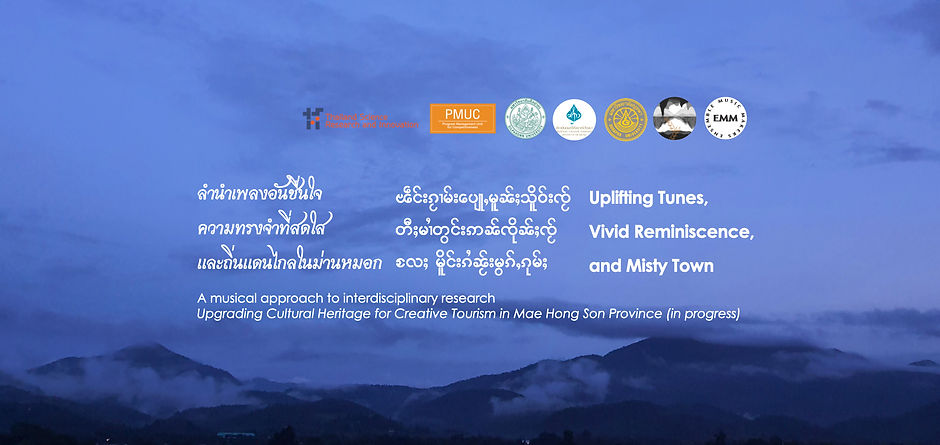Research Project
.png)
Innovation of Creative Music Process for Community Development Phase 2: Case Study Bang Yi Khan Community (2023-4 in progress)
"Innovation of Creative Music Process for Community Development Phase 2: Case Study Three Southern Border Provinces" aims to refine methodologies and practices in creative music activities and research tools. This phase will be conducted in the multicultural communities of the three southern Thailand border provinces, Yala, Narathiwas, and Pattani, building on the work done in Phase 1 in the Bang Yi Khan Community in Bangkok. The researchers plan to conduct music workshops targeted at young individuals in specific regions. Implementing an online audition process to select talented participants, and followed by organising an in-person workshop as an innovative music camp named "Inspirational Music Camp."This camp will emphasise collaborative songwriting and active engagement in the music creation process. The primary objective of this initiative is to inspire artistic work that represents individual identities and offers guidance for sustainable development through aesthetic, creative expression.

Innovation of Creative Music Process for Community Development: Case Study Bang Yi Khan Community (2023-4)
Human capital is the cultural value inherent to humans that takes time to understand. According to Amartya Sen (1999), the community and society benefit from this value. To help children develop creative potential and understand cultural identity, provide opportunities to learn musical skills through participatory creative musical activities. This can foster aesthetic creativity and help them reach their full potential. The objectives of the research are twofold. The first is to design innovative music activities and arrange music workshops for children residing in the Bang Yi Khan area. This will be accomplished by studying the changes in social context within the community culture. The second is to create musical compositions and publicly showcase the creative musical works resulting from participation.
Biedermeier Trio: Chamber music for violin, viola and guitar.
Kim, Margaret Hayne., Chantanakajornfung A., and Suwanpakdee S.(2022) Biedermeier Trio: Chamber music for violin, viola and guitar. Princess Galynai Vadhana Institute of Music. www.pgvim.ac.th/research/biedermeier
In every culture and time period, music has always been a medium of expression that gathers people together. In Thailand, the Sadhukarn, ceremonial music from the beginning of the Rattanakosin era (1782-1851), expressed a bodily and mental salutation to heavenly spirits, inviting and uniting the minds of the people towards one shared belief. In a parallel era in Central Europe, the music of the Biedermeier period (1815-1848) also had a unifying function as it grew out of societal conditions in which the distinction of classes became less pronounced. The search for a simpler, more natural aesthetic in music and the arts emerged as a response to the tumultuous events that had shaken European history preceding this era; it was a conscious, rigorous move to restore a sense of peace. This spirit of Biedermeier culture was the starting point for exploring new options in chamber music performance. The pieces studied and performed for this research were serenades written for the relatively rare combination of guitar, violin, and viola by Biedermeier-era composers Leonard von Call, Wenzeslaus Matiegka, and Anton Diabelli, as well as a newly created arrangement of the Thai Sadhukarn for the same combination of instruments. Upon investigation of the role that music written in the Austrian Biedermeier and Thai Rattanakosin cultural contexts had in the broader community, it was found that both cultures were strongly driven by the middle class, resulting in a conception of music that emphasized its accessibility and functionality in daily life. By performing these works, the aim was to transfer knowledge about the social function of this music to contemporary audiences of today.
Uplifting Tunes, Vivid Reminiscence, and Misty Town
Suwanpakdee S. (2022 in progress). Uplifting Tunes, Vivid Reminiscence, and Misty Town. In Upgrading Cultural Heritage for Creative Tourism in Mae Hong Son Province, (Kanoksilpatham B. et al). Program Management Unit Competitiveness, Thailand Science Research and Innovation.
Uplifting tunes,
Mae Hong Son's folk music is rich with stories that reflect the way of life through agriculture, rituals, traditions, and music. Beauty can be transmitted through sounds and infused with traditional culture, preserving the important identity of the people.
Vivid reminiscence,
Some stories may be recorded in the form of music and passed down from generation to generation, allowing future generations to comprehend and remember the roots of the ancient culture.
Far away land in the mist
Mae Hong Son is the city of three mists and diverse culture. Music … continues to perform these functions.




